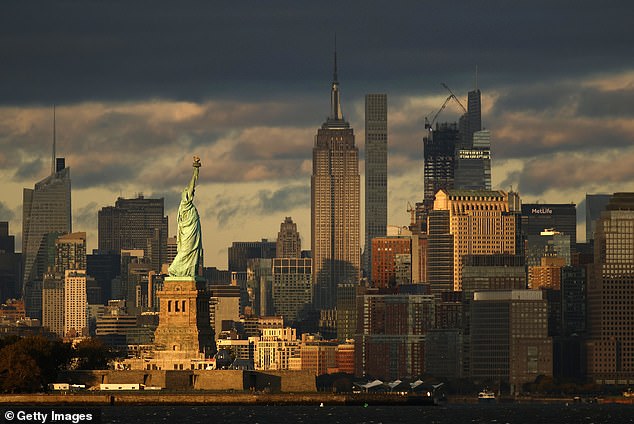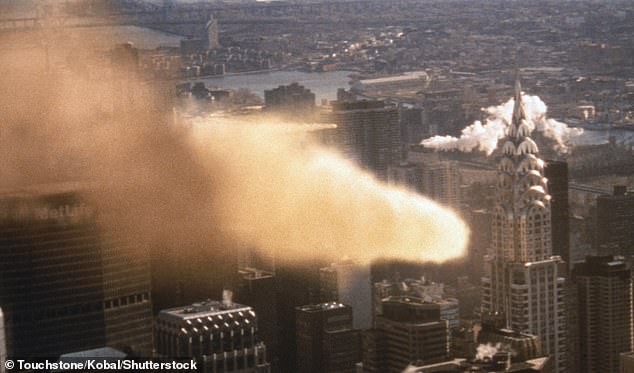Giant fireball meteor whizzes over Statue of Liberty as residents report feeling a shaking and hearing a ‘boom’
NASA reports that a meteor traveling 34,000 miles per hour (55,000 kilometers per hour) swept past the Statue of Liberty in New York Harbor on Tuesday, burning to ash above the city.
New Yorkers and even residents of neighboring states reported feeling an earthquake-like rumble and hearing a loud “boom” Tuesday morning as the bright, plummeting fireball engulfed itself in smoke an estimated 29 miles (47 kilometers) above midtown Manhattan.
Multiple government agencies responded to identify the mysterious, rattling explosion, including NASA’s Meteoroid Environments Office and the United States Geological Survey (USGS) National Earthquake Information Center.
But NASA noted that there was evidence for an alternative explanation.
“There have been reports of military personnel in the area around the time of the fireball,” the space agency said, “which could explain the vibrations and sounds reported in the media.”
NASA reports that a screaming 34,000-mile-per-hour meteor barreled past the Statue of Liberty in New York Harbor on Tuesday and burned itself up over the city. New Yorkers and even residents of nearby states reported feeling earthquake-like rumblings and hearing a loud “boom.”

But NASA noted that there was evidence to support an alternative explanation. “There are reports of military personnel in the area around the time of the fireball,” the U.S. space agency said, “which could explain the vibrations and sounds reported to the media.”
However, despite NASA’s warning, Pentagon officials said NBC New York that neither the North American Aerospace Defense Command (NORAD) nor any other U.S. military sensor network had tracked anything that could explain the witness statements.
Astronomer and head of NASA’s Meteoroid Environments Office, Bill Cooke, issued a statement about the limited facts currently known about the event.
According to Cooke, the fireball was first noticed during the day at 11:17 a.m. local time near Greenville Yard, a freight train station at the Port of New York and New Jersey.
“The fireball was first observed at an altitude of 49 miles over Upper Bay (east of Greenville Yard),” Cooke said.
“The meteor struck at an angle of only 18 degrees east of north,” he continued, “traveling at 34,000 miles per hour.”
The NASA official thanked the amateur sky watchers with the American Meteor Society whose data ‘enabled a very rough determination of the meteor’s orbit.’
Trackers for the nonprofit scientific group, founded in 1911, recorded about 20 possible meteor sightings between 11:16 and 11:20 a.m. The group’s unconfirmed reports of fireballs were scattered across the tri-state area, from New Jersey, New York and Connecticut — and on to Delaware and Maryland.
“It just struck me: a fireball shooting through the sky,” eyewitness Judah Bergman told local news. “I couldn’t believe it.”

Astronomer and head of NASA’s Meteoroid Environments Office Bill Cooke said the daylight fireball was first spotted at 11:17 a.m. local time near Greenville Yard, a freight rail station at the Port of New York and New Jersey, “moving slightly east of north at 34,000 miles per hour.”

“That’s what struck me: a fireball shooting through the sky,” eyewitness Judah Bergman told local news station NBC. “I couldn’t believe it.” Above, a still from the 1998 film Armageddon, in which space rocks threaten Earth, including New York City.
Despite reports from residents of physical rattling and shaking along the path of the fireball — reportedly coming from northeastern New Jersey and Staten Island, New York — the USGS said in an official statement that there was no evidence of an earthquake.
“A review of seismic data in the area showed no evidence of an earthquake. The USGS has no direct evidence of the source of the quake,” the federal agency’s National Earthquake Information Center said.
“Previous reports of tremors without an associated seismic signal often had atmospheric origins,” the USGS said, “such as sonic booms or weather-related phenomena.”
One explanation for the suspected and alleged noise of the meteor could be the unusually thick summer air.
As chief meteorologist for the local branch WABC-TVLee Goldberg noted that July’s record heat would cause sound to bounce through the air.
On days with high temperatures, air molecules move faster and collide more often in their heated or ‘excited’ state. This allows the sound waves that ripple through these molecular collisions to propagate faster and more powerfully.
NASA officials cautioned that their own assessment of the fireball sightings last Tuesday was “uncertain” and based on only “a few eyewitness accounts.”
“There are currently no camera or satellite data available to refine the solution,” the space agency’s meteoroid office acknowledged.
However, Cooke’s team at the NASA office promised to continue gathering information to corroborate the witness statements and thus complete the investigation into the matter.
According to NASA, no meteorite impacts or landings occurred on Tuesday.
